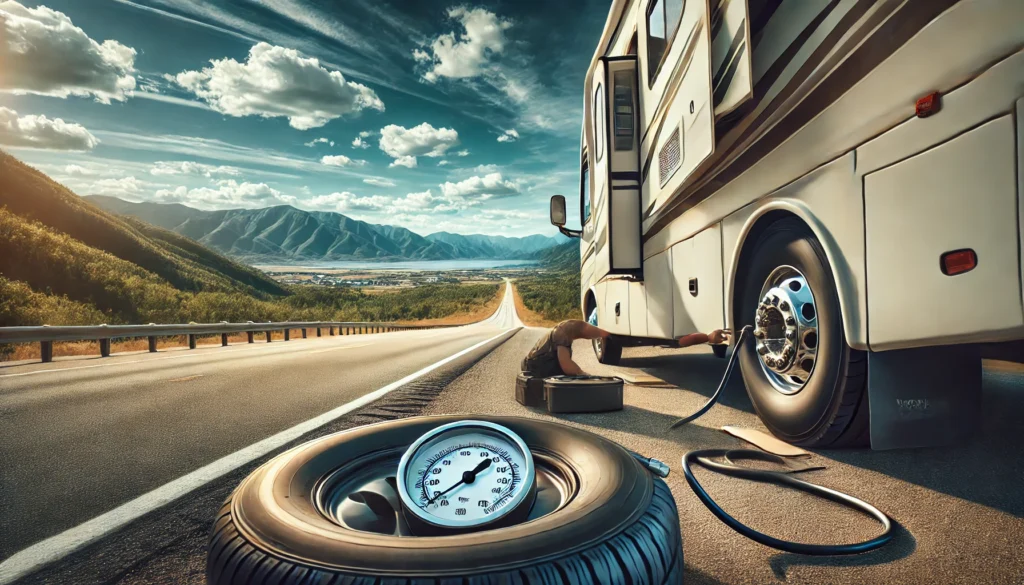Why Proper Tire Pressure Matters for Your RV
Whether you’re embarking on a weekend getaway or a cross-country adventure, maintaining the right tire pressure in your RV is crucial for safety, fuel efficiency, and a smooth ride. Incorrect tire pressure can lead to premature wear, poor handling, and even dangerous blowouts. This guide covers everything you need to know about tire pressure recommendations for all types of RVs, essential maintenance tips, and how environmental factors like temperature can impact your tires.
Recommended Tire Pressure for Different RV Types
Each RV type has specific tire pressure requirements based on weight, load distribution, and manufacturer specifications. Here’s a general guideline for different RV categories:
Motorhomes
| RV Type | Recommended PSI Range |
|---|---|
| Class A Motorhomes | 90-120 PSI |
| Class B Motorhomes (Camper Vans) | 50-80 PSI |
| Class C Motorhomes | 50-85 PSI |
Towable RVs
| RV Type | Recommended PSI Range |
|---|---|
| Travel Trailers | 50-80 PSI |
| Fifth Wheels | 65-110 PSI |
| Pop-Up Campers | 35-50 PSI |
Pro Tip: Always check your RV’s tire placard (usually located inside a cabinet or near the driver’s seat) or consult the owner’s manual for the exact PSI recommendations.
Essential Tire Pressure Maintenance Tips
Keeping your RV tires in top condition is key to a safe and enjoyable trip. Follow these simple yet effective tire maintenance tips:
- ✅ Check Tire Pressure Regularly: Use a quality tire pressure gauge before each trip and during long journeys.
- ✅ Inflate When Tires Are Cold: Tire pressure increases as the tires heat up. Always measure and adjust pressure before driving.
- ✅ Avoid Overinflation and Underinflation: Overinflated tires lead to reduced traction and uneven wear, while underinflated tires can overheat and cause blowouts.
- ✅ Balance Your Load: Uneven weight distribution can put excessive strain on certain tires. Weigh your RV and adjust cargo placement accordingly.
- ✅ Use a Tire Pressure Monitoring System (TPMS): A TPMS helps detect pressure changes and potential leaks before they become major issues.
- ✅ Inspect Tires for Wear and Damage: Look for cracks, bulges, or worn tread, and replace tires when necessary.

💡 Explore More: What is the best type of tire pressure gauge for RVs?

How Temperature Affects Tire Pressure
Temperature fluctuations can significantly impact tire pressure. A general rule of thumb is that tire pressure increases by approximately 1 PSI for every 10°F rise in temperature and decreases by 1 PSI for every 10°F drop.
Seasonal Tire Pressure Adjustments:
- 🌞 Hot Weather: Expect higher PSI readings. Slightly reduce pressure if exceeding manufacturer recommendations.
- ❄️ Cold Weather: Tire pressure drops, so check and inflate tires more frequently in winter.
📌 Pro Tip: Park in the shade when possible and allow tires to cool before adjusting pressure.
💡 Explore More: How do different road conditions impact tire performance in extreme temperatures?

Common Tire Pressure Mistakes to Avoid
- ❌ Neglecting Spare Tire Checks: Your spare should always be properly inflated in case of emergencies.
- ❌ Relying on Visual Inspection Alone: Tires can look fine but still be under or overinflated.
- ❌ Using Low-Quality Gauges: Invest in a reliable digital or analog tire pressure gauge for accurate readings.
- ❌ Ignoring Manufacturer Guidelines: PSI recommendations exist for a reason—always follow them.
Final Thoughts
Proper tire pressure is a fundamental yet often overlooked aspect of RV maintenance. By staying vigilant with regular checks, using the right tools, and understanding how factors like temperature affect pressure, you’ll enjoy safer travels, better fuel efficiency, and longer-lasting tires.
Before your next trip, take a few extra minutes to check your RV’s tire pressure—your safety and wallet will thank you! 🚐💨








